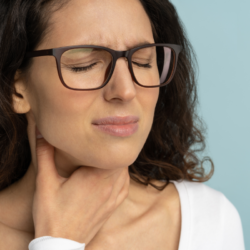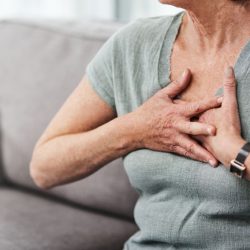Angina is an acute or sub-acute inflammation of the oropharynx, which may affect both tonsils or just one of them, and extend to the uvula, the pillars, the soft palate and the posterior wall of the pharynx. In the vast majority of cases, treatment is effective for these conditions, which may be the gateway to other infections (rheumatic fever, nephritis, etc.). However, in the case of group A streptococcal angina, if the practitioner is unsure of the patient’s potential, it is permissible to combine antibiotic therapy with the drugs indicated by the patient’s symptoms.
Erythematous angina (red angina)
Erythematous angina, also known as red angina, is a common form of angina caused by a bacterial or viral infection of the throat. In this article, we will discuss the symptoms, causes and treatment options available to sufferers of erythematous angina.
Belladonna :
-
Local symptoms:
The mucous membrane of the throat is red, dry and painful when swallowing. Sometimes, a spasmodic contraction of the throat muscles gives the patient the impression of a hand squeezing his neck. This sensation is aggravated by swallowing, and the pain may radiate to the ears. Cervical lymph nodes are often enlarged and painful.
-
General symptoms :
The temperature rises and fluctuates. The patient has a congested head and sweats profusely. The general symptoms are similar to those of the drug: aggravation by light, noise, touch and cold air; improvement in the dark and in a quiet environment.
Dosage: Take 5, 7, 9 CH, 5 granules every 2 or 3 hours. Space out according to improvement.
Apis mellifica :
-
Local symptoms :
The pharyngeal mucosa and tonsils are oedematous, pink-red. The uvula hangs like a water-filled wineskin. The pain is stinging and burning, improved by drinking cold fluids or sucking ice.
-
General symptoms :
Fever is high. The skin is alternately dry and covered in sweat. The patient is not thirsty.
Dosage: Take 9 CH, 5 granules every hour. Apis has a rapid but short-lasting action. Spacing out according to improvement.
Phytolacca decandra :
-
Local symptoms :
The pharynx is dark red, particularly on the pillars of the veil. The tonsils are swollen and the uvula is sometimes oedematous, but less so than in Apis. Swallowing causes pain that radiates to the ears. Sometimes there are small white spots, confluent with false membranes, which give the impression of a foreign body, with a constant need to swallow. The cervical lymph nodes are inflamed and enlarged.
-
General symptoms :
These are more discreet than those of the previous drugs; the whole body may feel sore or bruised.
Dosage: Take 5 or 7 CH, 5 granules every 2 or 3 hours, sometimes alternating with Belladonna.
Pultate and false membrane angina (white angina)
Pultate and false membrane angina, also known as white angina, is a common form of angina caused by a bacterial infection of the throat. In this article, we’ll discuss the symptoms, causes and treatment options available for sufferers of pustular and membranous angina.
Four mercury salts are particularly homeopathic for them:
Mercurius solubilis :
-
Local symptoms :
The pharynx and tonsils are red, with dysphagia radiating to the ears; presence of small white dots or thick false membranes. The tongue is characteristically flaccid and swollen, with tooth marks on the lateral edges. It is covered with a thick yellowish coating. Breath is foul, with abundant, thick saliva. Cervical adenopathy is present.
-
General symptoms :
High, plateau fever. The patient is shivering and sweating profusely, but is not relieved. Thirst is intense.
Dosage: Low dilutions (5 CH) tend to encourage suppuration. It is therefore preferable to take the medicine in 9 CH, 5 granules every 2 to 3 hours, or even in 15 CH for patients prone to phlegmons.
Alternation with Belladonna covers the reaction modalities of more than 80% of angina cases: the vast majority of patients suffering from angina present, simultaneously or alternately, symptoms identical to those caused by these 2 substances in healthy individuals. This had already been noted in 1849 by Rummel, a disciple of Hahnemann.
Mercurius biiodatus et protoiodatus :
-
Local symptoms :
These are erythematous or pustular lateralised or predominantly unilateral angina. Mercurius biiodatus is used in cases of preferential involvement of the left tonsil and Mercurius protoiodatus in cases of preferential involvement of the right tonsil.
-
General symptoms :
These are the same as those of Mercurius solubilis.
Dosage: Take one 9CH dose of the chosen salt morning and evening.
Mercurius cyanatus :
-
Local symptoms :
The pharynx presents false greyish membranes, adherent, difficult to detach, covering bleeding ulcers. Cervical adenopathy is painful to the touch.
-
General symptoms :
The general condition is profoundly affected, with prostration.
For homeopaths,Mercurius cyanatus was once “the medicine” for diphtheria. Even today, it can be an effective adjuvant to serotherapy for this condition.
Dosage: In severe, non-diphtheria, false membrane angina, take one tube-dose of Mercurius cyanatus morning and evening. During the day, alternate every 2 hours, 5 granules of Belladonna 7 or 9 CH with 5 granules of Mercurius solubilis or Mercurius corrosivus 9 CH, depending on the clinical symptoms.
Ulcero-necrotic angina (presence of one or more ulcerations)
Ulcero-necrotic angina is a rare but serious form of angina characterised by the presence of one or more ulcerations in the throat. In this article, we’ll discuss the symptoms, causes and treatment options available for sufferers of ulcerative sore throat.
Mercurius corrosivus:
-
Local symptoms:
This medicine is suitable for ulcerations of the throat, of rapid extension, which burn like burning coals, on a swollen, painful, inflamed mucous membrane. The pain is aggravated by the lightest touch. Swallowing is hyperalgesic, even for liquids; it causes spasms and constriction of the throat. The ganglia in the neck are enlarged and hypersensitive.
-
General symptoms :
These are the same as those of Mercurius solubilis.
Dosage: Take 7 or 9 CH, 5 granules 4 times a day.
Lachesis mutus :
-
Local symptoms :
The tonsils become swollen, dark red in colour, ulcerated, causing feelings of constriction with intolerance to the slightest external contact. Swallowing is more difficult for saliva and hot liquids than for solids or cold liquids.
-
General symptoms :
The general condition is very affected, with dejection, adynamia.
Dosage: Take 9 or 15 CH, 5 granules 2 times a day.
Kalium bichromicum :
-
Local symptoms :
These are regular-edged, cookie-cutter ulcerations with tenacious yellow or greenish-yellow viscous exudations. They occur mainly on the pillars of the soft palate; on the uvula, they cause localised oedema which makes it hang like a small bag filled with water(Apis).
-
General symptoms :
These are generally fairly discreet.
Recommended dosage: Take 5 CH granules 2 to 4 times a day, depending on the severity of the case.
Ailanthus glandulosa :
-
Local symptoms :
The throat is dark red, with small purpuric spots or ulcerations. The tongue is dry, sometimes brown, and swallowing is very painful. Cervical adenopathy is extensive and very tender. Breath is foul.
-
General symptoms :
The general state is very affected: adynamia, prostration, stupor, with a congested and puffy face. This medicine is indicated in monocytic angina and certain malignant angina, in combination with conventional treatments if necessary.
Dosage: Take 5 or 7 CH, 5 granules approximately every 6 hours.
When should Ailanthus glandulosa be used?
Ailanthus glandulosa is particularly indicated in the following cases:
- Febrile conditions: This remedy is often recommended for high fevers, particularly those accompanied by facial flushing, burning and intense headaches. It is effective in treating fevers that occur rapidly and may be associated with infectious diseases.
- ENT and Respiratory Infections: It is used in the treatment of angina, pharyngitis and other upper respiratory tract infections, especially when accompanied by stabbing pain, difficulty swallowing and swollen lymph nodes.
- Skin rashes and allergies: Ailanthus glandulosa is indicated for skin rashes, particularly those resembling scarlet fever, with red skin and blotches. It is also useful in cases of skin allergies where the skin is irritated and itchy.
- General condition: This remedy can be useful in cases of general weakness, exhaustion and malaise, especially after an infectious disease.
Arum triphyllum :
-
Local symptoms :
The larynx is bright red. The pain is sharp and tight. Saliva is also abundant. The tongue may become peeling and raspberry-like.
-
General symptoms :
Severe: fever is very high. The patient may be prostrate or agitated. They constantly pull small scales from their lips, with their fingers or teeth, and may bleed. It is therefore a medicine for severe angina, often scarlet fever. Nowadays, it is mainly used in addition to antibiotic treatment.
Dosage: Take 5 or 7 CH, 5 granules 4 times a day.
When should Arum triphyllum be used?
Arum triphyllum granules can be used in the following situations:
- ENT disorders: Arum triphyllum is particularly indicated for disorders of the upper respiratory tract. This includes laryngitis, pharyngitis and rhinitis, particularly when they are characterised by a burning sensation and severe inflammation of the throat, nose and lips.
- Mouth inflammation and pain: This remedy is often recommended for pain and inflammation of the mouth and tongue. It is useful for mouth ulcers, reddened and swollen tongues, and when talking or swallowing becomes painful.
- Changes to the voice: Arum triphyllum may be recommended in cases of changes to the voice, such as hoarseness, especially when this is linked to over-use of the vocal cords (for example, in singers or speakers).
- Irritating nasal discharge: It is also used to treat an acidic nasal discharge which irritates the skin of the nose and lips, causing redness and cracking.
- Behaviour in children: In certain cases, Arum triphyllum is indicated for children who tend to put their fingers in their mouths and irritate their lips and mouth, often during periods of ENT disorders.
Phlegmonous angina
Homeopathic therapy must be initiated early. Otherwise, treatment will be essentially antibiotic or surgical.
Pyrogenium :
This biotherapeutic is a medicine to be used in all serious infections, with impairment of general condition and dissociation of pulse and temperature. The secretions have a putrid odour. It is not necessary – or desirable – to wait until this clinical stage before taking it, as it is highly effective in preventing or stopping suppurative processes. It should be used at the very beginning, before the collection has formed or, on the contrary, when the suppuration is in the process of draining. This medicine should be avoided once a collection has formed, as it will delay the maturation of the abscess or the evacuation of the pus.
Dosage: Take one 9CH tube-dose, in combination with :
Hepar sulphur :
This is the essential medicine for acute suppuration. Its dosage obeys very strict rules, depending on the differences in its action according to the dilution level; high dilutions (15-30 CH) slow down or reabsorb suppuration, low dilutions (4-5 CH) favour suppuration and medium dilutions (7-9 CH) are ambivalent and act in one direction or the other depending on the clinical stage of the suppuration.
In the early stages of a phlegmon of the tonsil, it is effective to use the “ladder” prescription:
- As soon as the infection begins, take a tube of Pyrogenium 9 CH and, 2 hours later, a tube-dose ofHepar sulfur 9 CH
- 12 hours later, take a tube-dose ofHepar sulfur 12 CH, always preceded 2 hours earlier by a tube-dose of Pyrogenium 9 CH
- 24 hours later, a tube-dose ofHepar sulfur 15 CH, preceded 2 hours before by a tube-dose of Pyrogenium 9 CH
- 24 hours later, a tube-dose ofHepar sulfur 30 CH, again 2 hours after a tube-dose of Pyrogenium 9 CH
In all cases of angina, in addition to the general treatment, it is useful to gargle 4 or 5 times a day with equal parts of Phytolacca T.M. and Calendula T.M., 20 drops in half a glass of lukewarm water. This local treatment has remarkable analgesic and antiseptic properties.






Thanks for the brilliant article.
We are delighted that you enjoyed our article! À bientôt sur Soin et Nature